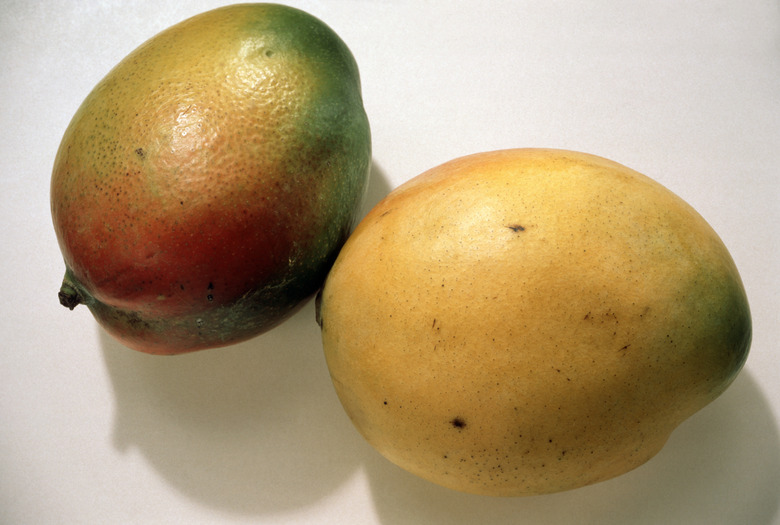Mango Trees In The Bay Area
Mangoes (Mangifera indica) are produced on evergreen trees from India that grow to 50 feet or more in tropical environments. They can be grown outdoors in U.S. Department of Agriculture plant hardiness zones 10b through 11, though there are dwarf varieties that can be grown indoors in colder climates. In Northern California's Bay Area, winter temperatures occasionally dip below freezing, so mangoes need to be covered or brought indoors to prevent freeze damage in the winter.
Step 1
Mangoes can tolerate any soil type found in the Bay Area, as long as it is well-drained. They tolerate soils with a pH anywhere from 5.5 to 7.5. The trees are self-fertile, so it is possible to have fruit with only one specimen. They do need a lot of heat to grow well and ripen their fruit — summer temperatures in the 80s and 90s (degrees Fahrenheit) are ideal — so growing them indoors year round may be necessary in the foggy coastal zones of the Bay Area. In the warmer inland landscapes of the region, they should be planted against a south-facing wall for maximum warmth in both summer and winter, though they will need some form of frost protection in these areas on the coldest nights of the year. Mangoes grown in the dry summers of the Bay Area need regular irrigation to survive, but it is important to let the soil dry out between waterings.
Cold Protection
Step 1
Mango flowers and fruit are damaged at temperatures below 40 degrees Fahrenheit, and young trees can be killed at temperatures below 32 degrees. The trunks of mature trees may survive temperatures as low as 25 degrees, however. One option in the Bay Area is to plant the trees in the ground and cover them with plastic whenever freezing temperatures are forecast. The plastic should be staked or weighed down at the edges to prevent cold air from entering at soil level. This method provides a few degrees of protection and is only feasible with small trees. If planted in pots, the container should be at least 20 gallons in size and mounted on casters so it can easily be rolled indoors.
Step 2
- Mangoes can tolerate any soil type found in the Bay Area, as long as it is well-drained.
- Mangoes grown in the dry summers of the Bay Area need regular irrigation to survive, but it is important to let the soil dry out between waterings.
Pests and Disease
Step 1
If mangoes are kept indoors for more than a few cold days in winter, they need to be in a location with good ventilation and at least eight hours of direct sun each day — otherwise they are likely to suffer from fungal diseases and a host of insect pests. Anthracnose is the most common of these and is best prevented by using a fan to maintain constant air circulation around indoor mango trees. Various mites, mealybugs and scale also affect mangoes and are exacerbated by indoor conditions. If it's feasible, hosing off the tree every morning is the best prevention for these pests when growing it indoors on a continuous basis.
Dwarf/Indoor Varieties
Step 1
Full-size mangoes can be planted in containers and maintained at a height of 12 feet or less. True dwarf varieties have been bred specifically for their adaptability to indoor growing conditions, allowing them to be grown in a greenhouse or solarium year round, or brought into a garage or other protected space on cold winter nights. "Julie" is the smallest of these and produces orange fruit of excellent eating quality. However, it is very prone to disease when grown indoors. "Carrie" is another compact variety that has fiberless fruit and has been bred for better disease resistance. "Thomson" is a variety that does well when planted outdoors in cool, coastal areas.
Step 2
- If mangoes are kept indoors for more than a few cold days in winter, they need to be in a location with good ventilation and at least eight hours of direct sun each day — otherwise they are likely to suffer from fungal diseases and a host of insect pests.
